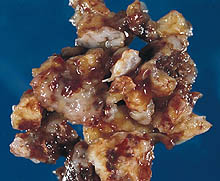| Home A B C D E F G H I J K L M N O P Q R S T U V W X Y Z |
|
Home |
Transient Ischemic Attack:
|
|
 A 71-year-old man had transient ischemic attacks; transesophageal echocardiogram showed a left atrial mass. Note the irregular surface, a feature associated with embolism. |
A transient ischemic attack, spelled ischaemic in British English, abbreviated as TIA, often colloquially referred to as "mini stroke", is a change in the blood supply to a particular area of the brain, resulting in brief neurologic dysfunction.
SYMPTOMS:
Loss of vision in one eye or blurry vision in both. Feeling of unsteadiness and general loss of balance. Slurred speech. Difficult finding the right words. Problems understanding what other people are saying. Numbness on one side of the body. Weakness or paralysis on one side of the body, affecting one or both limbs. Loss of consciousness.
CAUSES:
Transient ischemic attacks consist of episodes of temporary loss of function in one area of the brain, resulting from a reduced blood supply to the brain.
Part of the brain suddenly and briefly fails to function properly because it is temporarily deprived of oxygen by blockage of its blood supply. This can last 1 second to 1 hour and has no aftereffects. If the symptoms last longer than an hour, it is called a stroke. In the U.S., about 1 in 600 people after the age of 45 has a TIA. Attacks are three times more likely in men. If the underlying problem is not solved, about 1 in 3 later has a stroke. So a TIA should not be ignored!
A thrombus usually forms in blood vessels that are affected by atherosclerosis, a condition in which fatty deposits build up in blood-vessel walls. Those at increased risk are smokers and those on a high-fat diet. Other risk factors are diabetes mellitus, high blood pressure, and sickle cell anemia.
|
Glossary References Links Contact
|